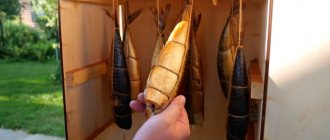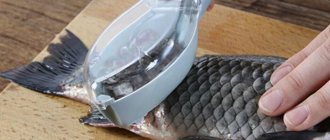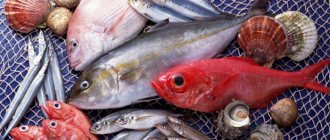- Shelf life: 6 months
- Shelf life: 6 months
- Shelf life in the refrigerator: 3 months
- Freezer life: 12 months
Storage conditions:
In a cool, dry place at a temperature not exceeding +8 ° C and a relative humidity of not more than 70%
The name of this delicious fish comes from one of the subspecies of river fish - or rather carp, which is called ram. At the moment, ram refers to almost all dry or dried fish. In addition to ram, roach and roach are dried, but if you have experience and skills, you can also prepare bream, perch or large crucian carp.
In central Russia, this particular fish is considered the best addition to beer, and its lovers often argue about tastes - which is the most delicious, dried or dried. Preparing dried fish can take more than one week, depending on the recipe chosen and the size of the fish.
Main differences in storage
To learn how to store dried fish at home, let's draw a line between dried and dried products. Dried fish is initially ready to eat, while salted fish requires additional processing. Discrepancies are also observed in the selection of varieties. Lean ones are used for drying, and fatty ones for drying.
The storage options for dried and dried carcasses are largely similar. The differences affect the degree of humidity and temperature. Dried fish needs higher levels of humidity and warmer conditions.
Useful tips
Dried fish contains fats, so if storage conditions are violated, it may go rancid and the product will become unsafe. To preserve the taste of the product, it is necessary to take into account the following nuances:
- It is necessary to monitor the humidity of the room where the fish are hung so that the carcasses do not become moldy or dry out.
- The suitability of the finished product directly depends on the quality of the raw materials.
- If there is an unpleasant odor, strange threads inside the carcasses, or a change in the color of the flesh, it is better not to consume such specimens.
Storage rules
Storage conditions for dried fish are based on three factors - lighting, temperature and humidity level. To preserve the product, you must:
- prevent exposure to sunlight;
- set the temperature to no higher than 10 degrees;
- maintain humidity at least 70-80% to prevent drying out.
Storing dried fish is based on the same parameters, but the requirements for them are slightly different. At home, to store carcasses you will need:
- place the product in a dark place;
- select temperature conditions in the range of 3-10 degrees;
- find a room in the apartment with a humidity level of 60-70%;
- ensure air circulation in the container.
Dried bream: salting at home - a recipe for salting and drying large fish without gutting
To get delicious dried bream at home, you need to go through several steps:
- Preparing bream for salting,
- Salting fish using dry salting method,
- Soaking the fish after salting
- Drying and drying bream
How to properly prepare bream before salting
First of all, after bringing your catch home, all the fish must be cooled. Put it in the freezer for a couple of hours.
This way your fish will be reliably preserved and odorless. And with this cooling we will get rid of some parasites if they are present in the fish.
How to properly salt bream for drying at home
Salting bream is not difficult. It is necessary to start salting with large individuals.
Next, we proceed to salting the bream. To do this, you first need to select the container size you need.
Ikea and other mega-superstores sell plastic boxes with handles. They are just perfect for salting bream - large and deep.
First of all, pour some salt into the bottom of the box. Then we fill the gills with salt, since it is from the head that the fish begins to spoil (as you and I know well).
Some immediately remove the gills and make an incision in the abdominal part so that the fish is better salted. But I assure you that it will be salted just fine anyway.
Next, we lay all the fish in layers “jack” (that is, head to tail, tail to head). Don't forget to sprinkle each layer with a little salt.
When all the bream is laid, take a piece of plywood or a board of the required size and place it on top of the salted fish. We press down with our weight and place pressure on top (load - the more fish, the heavier the load).
We put it in the refrigerator for a week - no less, or even 10 days. You can spend the first two days so that the fish gives juice without putting pressure on it. But every day you need to take the fish out of the refrigerator and press it again. This is necessary so that all the air inside comes out.
I don’t do quick salting, because it seems like the fish will pick up salt in a couple of days, but fermentation of the meat will not occur and it won’t be the same dried bream like store-bought.
If there is a lot of fish, then some can be left for drying and drying, and the rest can be packed in bags and placed in the freezer. And if necessary, deliver several fish.
How to properly soak bream after salting
After salting, any fish must be thoroughly soaked. This is done so that the excess salt is removed and we do not end up with over-salted bream.
To soak bream you will need a larger container than for salting. You can set aside a bathroom in your apartment for this (if your spouse and all household members do not mind).
First, we wash each bream under the tap. Then we place it on the bottom of the bath and fill it with cold water.
In the summer, when it is very hot, you should put a few pieces of ice in the fish bath.
The easiest way to dry and cure bream without gutting at home in summer and winter
You can dry bream in an apartment, but the best place, of course, is in a private house, where there is somewhere to hang all the fish.
Drying should be done in a cool and well-ventilated area. Small bream should be hung by the head, and large bream by the tail.
For a quick effect, especially in isolated places, such as an apartment, it is better to dry and dry the bream under a fan.
After drying, dried bream turns out to be very tasty without any odor, and when cut, the meat has an amber transparent color.
This is interesting: Carp on the grill - how to cook it, shish kebab recipes, what you can bake it with
Storage methods
The answer to the question of how to store dried fish at home depends on your end goals. For short-term storage, no special equipment is needed. Long terms require additional conditions. These may include sealed containers, low temperatures, high salt content, or the addition of alcohol.
Short term storage
The rules for short-term storage of fish products are simple. To prevent fish from spoiling, two conditions are needed:
- air humidity level up to 80%;
- stable temperature up to 8 degrees.
Compliance with these rules will allow you to store the carcasses at home for the next seven days. To prevent the fish from drying out, you need to put it in a cardboard box. The box will fit more carcasses if you cut off their fins.
To store the semi-finished product correctly, you will need a wrapper. Plain paper is suitable for this purpose. In paper packaging, the fat does not oxidize and the carcass does not dry out.
In foil
Foil serves as temporary packaging for fish during transportation of the product. It allows you to preserve carcasses for 1-2 days. To use this method, you must first freeze the dried fish, then remove it and wrap it in foil. The package itself is protected with stretch film.
If you put the carcasses in foil in a tremo bag, they can be kept in the heat for up to one and a half weeks in the summer.
Long term storage
The “recipe” for long-term storage of carcasses depends on the available means. You can keep the product in the freezer, glass or tin jar, salt solution, etc. All these methods help preserve fish for a period of six months to 2 years - subject to strict adherence to conditions.
In a vacuum
Vacuum packaging will extend the shelf life of the product by 3-4 months, regardless of the time of year. Dry and lean fish can be kept longer than lightly dried and fatty fish. Storage of fish in a vacuum takes place in the refrigerator at a temperature of 2 to 4 degrees. Before this, the product must be packaged. This method is rarely used by amateur fishermen, as it requires special equipment.
You cannot put dried fish in a plastic bag without vacuum packaging. Upon contact with polyethylene, condensation is released. High humidity causes the fish to become moldy.
On a rope
Hanging fish at home is suitable for those who have a pantry, balcony or attic. Other dark and cool rooms with humidity up to 80% are also suitable. Before placing the carcasses on the rope, they need to be wrapped in parchment. This way the ligaments will smell less and the fish will not dry out. Large carcasses are wrapped separately, small ones - 3-4 pieces. If desired, you can skip the wrapping step.
Supplies are attached to the rope using hooks. The fish are hung at intervals of 3-5 cm and covered with gauze. The fabric will protect the product from “attack” by insects. There is no consensus on how long dried fish can be stored on a rope. The period depends on the condition of the fish and the microclimate in the room. Approximate figures: from 4 months to six months.
The room in which the fish is hung must be regularly ventilated, otherwise by the time it is consumed it will be dry and hard.
In glass
For the preparation you will need a glass jar with an airtight lid, a seaming key, a candle and matches. The candle will need to be thin and long, since it will have to fit in the center of the jar. The cooking process is as follows:
- Sprinkle a thin layer of salt on the bottom of the container.
- Place the dried fish in the jar vertically (cut if necessary).
- Place the carcasses so that there is room for a candle in the center.
- Place the candle so that the wick does not reach 3 cm from the neck.
- Light the candle and close the lid on top.
- Roll up while the candle continues to burn.
- Place the jar in a dark place and store at room temperature.
The long shelf life of salted fish sealed in this way adds flavor. The longer the preparation sits, the richer the carcasses become. Over the course of 2-3 months, the salt is distributed evenly over all fish and saturates them.
The point of lighting a candle is that the fire removes oxygen. As a result, a “homemade” vacuum appears in the container.
In tin cans
You can keep dried fish at home without a refrigerator. A tin can with a tight-fitting lid will be a strong competitor to vacuum packaging. The method is equally suitable for both fresh and dried products. Tin containers store the product longer than glass ones because they do not allow sunlight to pass through.
In the bag
A linen bag is used when carcasses are stored in the attic or balcony. Before packaging, carcasses are wrapped in parchment or pieces of natural linen. You should not take newsprint as consumables - printing inks are hazardous to health. If the fish is stored for a long time, they are absorbed into the scales.
Supplies wrapped in cloth are placed on shelves lined with straw or sawdust in the pantry. Fish are stored in bags for up to three weeks. At this time, they ripen in the cool: at temperatures up to 15 degrees. During this period, the carcasses are impregnated with salt, which enhances the taste of the finished product.
In saline solution
The brine is designed for fresh fish - carcasses are stored under pressure for six months. If desired, the contents of the jar can be taken out earlier and hung to dry. But before hanging, the fish is soaked in cool water, otherwise the final product will be over-salted. It is not advisable to re-immerse carcasses in brine. The meat will sour and soon rot. Salting is a one-time procedure.
In vodka
To store fish in vodka you will need a container with an airtight lid. 50 grams of alcohol are poured into the bottom of the container. Supplies are placed in containers and tightly closed. The container is placed on closed shelves so that sunlight does not fall on it.
Vodka will kill all harmful microbes and maintain the required level of humidity. The storage time for dried fish in vodka is 10-12 months.
In a refrigerator
A refrigerator is suitable for storing supplies if there are few fish. The main problem with refrigeration chambers is the risk of drying out the product in them. Dry fish will lose its taste and will be unsuitable for consumption. To prevent this from happening, you need to choose suitable packaging - wrapping paper. The carcasses are wrapped in 2-3 layers, and holes are made in the material for “ventilation”.
The duration of storage depends on the type of fish. The ram lasts for up to six months, flounder and roach do not spoil for up to ten months.
In the freezer
The freezer keeps dried fish fresh for as long as possible. Fish stocks last up to one and a half years. But in practice, the product is rarely stored in the freezer for more than six months. The reason is simple: after prolonged freezing, the carcass loses its taste and smell.
To prevent the tart aroma of the supplies from spreading to neighboring products, the fish are wrapped in food paper. The vacuum method is also suitable, but such packaging is not readily available at home. Products are stored at temperatures from -5 to -18 degrees.
Before freezing fish, make sure that it will not come into contact with raw meat or minced meat. Such contact can ruin both minced meat and carcasses.
In a cellar or closet
Carcasses can be kept in the cellar in different ways - in boxes, on a line or on shelves. Before placement, the fish are wrapped in tracing paper or parchment and then hung. When putting supplies in a box, it is not necessary to wrap each carcass in paper.
The rows of boxes are lined with straw or shavings. Fish are placed on them in rows. If the temperature and humidity levels are maintained, supplies can be stored for up to six months.
Storage in a box
Store for a long time
A large amount of dried fish in boxes, paper, and containers will not last long. Canning and freezing will keep a lot of dried fish throughout the year. I offer two proven methods:
| Photo | Instructions |
| Method 1. Freezing The easiest and most reliable way is freezing. The product will not lose its taste and beneficial qualities throughout the year. Remember that repeated freezing is unacceptable. To properly preserve fish:
Good briquettes are obtained when using polyethylene sealing | |
| Method 2. Canning In a jar with a tightly closed lid, all types of dried products, including ram, roach, and bream, can be stored for 6-8 months. The preservation process is suitable for small and medium-sized carcasses and consists of several stages:
|
The shelf life of frozen roach is reduced if the temperature is below -8 °C. Rolled jars should be placed in a cool room where there is no sun.
Shelf life
The storage time for fish products is determined by the chosen location, packaging and indoor climate. The quality of the purchased carcasses also plays a role.
| Conditions | Shelf life of dried fish | Shelf life of dried fish |
| Room temperature | 14 days | 30 days |
| Fridge | 4 months | 6 months |
| Freezer | 1 year | 2 years |
| Cellar or balcony | 6 months | 10 months |
| Vacuum packaging | 1 year | 1 year |
The duration of fish storage is stipulated by state standards, which are based on the percentage of fat in the product. The shelf life of dried fish according to GOST is as follows:
- fat content exceeds 10%: 2 months;
- fat content does not reach 10%: 4 months;
- freezer (regardless of fat mass): 5 months.
In accordance with GOST requirements, fish is stored in a refrigerated store display case. For carcasses without packaging, a temperature range of 0 – 8 degrees is provided. Fish are stored in film at a temperature of -18 – 0 degrees.
To answer how best to store dried fish at home, you need to take into account its type. Common varieties (flounder, bream, ide, roach) can be kept for up to a month if three conditions are met:
- temperature up to 8 degrees;
- humidity level 65 – 80%;
- packaging: paper or fabric.
In this sense, the question of how to store roach at home does not have a unique answer. The conditions are the same for most popular varieties.
Shrinkage percentage
During storage, the workpiece may lose size and shrink due to non-compliance with temperature and humidity conditions, as well as when interacting with oxygen. According to GOST, the permissible percentage of shrinkage relative to the original mass is 0.03-0.08%.
You should not put fish in plastic, as it can cause the growth of bacteria and mold.
How to soften dry fish
If dried carcasses cannot be served, then you can “reanimate” them. There are different ways to soften: in boiling water, in the oven, in a steamer, and even with wet rice. When working with hot water, the procedure is as follows:
- Heat water in a saucepan until boiling.
- Immerse the carcasses in it for 15 minutes.
- Remove the fish from the water and wrap it in a towel.
- Wrap the towel in cellophane and place it on the radiator for an hour and a half.
Before putting the fish in the oven, it is washed and covered with foil. You need to pour a little water into the foil to steam the carcasses. The oven is set at 180 degrees and runs for 30 minutes.
Suitable for dried fish and steamer. The instructions are as follows:
- Cut the fish into equal pieces.
- Spread gauze in 2-3 layers on the mesh of the steamer.
- Place the pieces on the mesh and cover with a new layer of gauze on top.
- Steam the workpieces for an hour.
Tips from the forums
1. Use cling film if there are no bags or vacuum equipment . Many fishermen use the freezer for storage.
3 hatch:
There are no vacuum bells and whistles, then just wrap it well in portions in cling film and put it in the freezer.
Source forum.sakh.com
2. Option for large specimens . Dampen a canvas or linen cloth, wring it out and wrap the fish. Place in the vegetable drawer of the refrigerator. This way the products are stored for 1-2 months.
YuVK:
It is almost impossible to preserve large dried fish in its original form in an apartment. Try a canvas or linen rag, soaked in water and wrung out, put the fish in it, and put it in the refrigerator or vegetable drawer. It will help for a while. hardvik, What’s in the jar, what’s in the bag, if it goes rancid in the heat and in the light. Fat oxidizes from temperature and from light, considering that both are hermetically sealed.
Source forum.homedistiller.ru
3. Use large black bags . Place one inside the other and fill in everything that needs to be preserved. Release as much air as possible and store in a dark place.
igor-xp:
Fish in a bag and in the refrigerator.
Source volgafishing.ru
Protection against flies during drying
The question of how to store dried fish so that flies do not eat it arises when the carcasses are taken outside. To prevent insects from laying larvae in the product, fishermen resort to various tricks:
- Cover the fish with a mesh cloth (for example, gauze or a mosquito net). The fabric should be placed so that it does not touch the fish themselves.
- Boxes are made, the walls of which are protected with gauze. The frame of the box is lined with wooden blocks.
- Dip the supplies in a solution of vinegar and sunflower oil (in proportions 6:4). The fish is coated with the mixture daily while it is outside.
For 3 kilograms of fish you will need 0.5 liters of vinegar-oil solution. For large gutted specimens, cotton wool moistened with the same composition is placed in the abdomen.
How to tell if fish has gone bad
Fish is a product whose spoilage immediately makes itself known. But a sharp unpleasant odor is not the only symptom that signals the condition of the carcass. You can tell that a fish has gone bad by the following signs:
- the fish has turned yellow (a yellow tint appears in the belly area);
- the gills were covered with grayish mucus;
- the meat has lost its elasticity and does not stick to the bones;
- the scales turned green and began to peel off;
- mold appeared on the surface of the fish;
- There are parasites in the insides.
Mold should not be confused with whitish plaque. The cause of plaque is crystallized salt. Salt indicates that the carcass is drying out.
To stop this process, the plaque is wiped off, and the fish is wrapped in a cloth soaked in saline solution for 5 hours. It is advisable to eat processed fish immediately – within 48 hours.
Product selection rules
Not all consumers are familiar with the production technology of this delicious and aromatic delicacy, so not everyone will be able to distinguish a quality product from a spoiled one.
The main signs of low-quality fish products include:
- The presence of a grayish-white coating on the scales. Sellers will mislead you by claiming that this is leaking salt. But this is not true at all - the fish is simply covered with mold.
- The first prohibition against purchasing is the presence of even a slight musty smell.
- You should not buy fish that are too dry (ram, bream) - after a while it will completely harden and it will simply be impossible to eat it. Although such a product has its fans.
- When buying fish that is too wet, you risk getting poisoned - it contains microbes harmful to the human body.
- If your fish smells like iodine, don't worry - this is a natural process of fish oil oxidation.
- A yellowish and slightly soft belly indicates a slight and acceptable deterioration in product quality.











